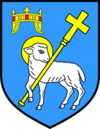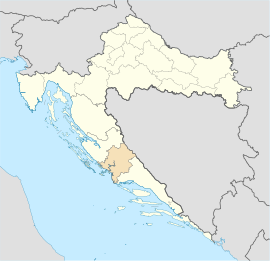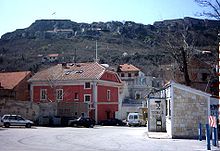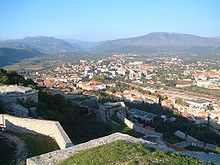Knin
|
Knin Книн |
||
|
||
|
|
||
| Basic data | ||
|---|---|---|
| State : |
|
|
| County : |
|
|
| Height : | 214 m. i. J. | |
| Area : | 355 km² | |
| Residents : | 15,407 (2011) | |
| Population density : | 43 inhabitants per km² | |
| Telephone code : | (+385) 022 | |
| Postal code : | 22 300 | |
| License plate : | ŠI | |
| Structure and administration (as of 2016) |
||
| Community type : | city | |
| Mayor : | Nikola Blažević ( HDZ ) | |
| Postal address : | Ul. Dr. Franje Tuđmana 2 22 300 Knin |
|
| Website : | ||
| Others | ||
| City Festival : | June 13th | |
Knin [ ˈkniːn ] ( Serbian - Cyrillic Книн , Italian Tenin ) is a town in the Croatian Šibenik-Knin County . It is located 56 km from the coast in the hinterland of northern Dalmatia , in the headwaters of the Krka River .
history
Around 1080 Knin was the seat of the Croatian King Dmitar Zvonimir . After the death of King Petar Svačić and the subsequent personal union with the Kingdom of Hungary , Knin increasingly lost its importance. On May 29, 1522, Knin was conquered by the Ottomans and came to Ottoman Bosnia . Some of the local Croats left the city. On September 11, 1688, Knin was conquered by Venetian troops. Through the Peace of Karlowitz it came under the rule of the Republic of Venice and became part of the province of Dalmatia . After that, Croatians increasingly moved to the city again and a Franciscan order built a monastery and church in 1708.
In 1797 Knin came to the Habsburgs along with the rest of Dalmatia .
At the time of the Ottoman and Venetian rule, numerous Orthodox settlers settled in the region around Knin. In numerous villages in the area around Knins, Serbian Orthodox graves, churches and monasteries are 200 to 300 years old. Wallachians have also lived there since the 17th century.
Croatian war
During the Croatian War from 1991 to 1995, the city of Knin, which was predominantly inhabited by Serbs, was under Serb control and functioned as the capital of the Republic of Serbian Krajina . Dragan Vasiljković , later convicted of war crimes, led the majority of the local paramilitaries . The Croatian population of the city and the surrounding area was almost completely expelled in 1991/1992, their houses looted and set on fire, and Catholic churches and monasteries devastated.
In 1995, the city was captured by the Croatian Army during the Oluja military operation , which, according to indictments at the International Criminal Tribunal for the former Yugoslavia , committed serious crimes against the civilian population after most of the Serbian population had previously fled.
After the end of the war, most of the expelled or fled Croatians returned. Some of the Serbs have also returned, especially since the change of government in 2000.
population
The city had 15,407 inhabitants at the 2011 census. The majority of the population made up the Croats with 75.37%. 23.05% described themselves as Serbs. Before the Croatian war , the Serbs formed the majority (79%).
Attractions
The main attraction of Knins is a large ruined fortress on Mount Spas . Every year on August 5th, the fortress is one of the scenes of the Victory Day festivities and local gratitude .
The source of the Krka River is located on the edge of Knin . If the source river Krčić carries water, which is usually only the case from the snowmelt until the summer due to the karst conditions, there is a waterfall at the source.
traffic
Knin is connected to the national road network via the Croatian state roads D1 and D33 . In the foreseeable future, the D33 state road to Šibenik is to be modernized and, in parallel, an expressway to the coast via Oklaj and Drniš will be built.
Knin station is located on the railway line from Oštarije to Split , which is also where the line to and from Zadar and the Una railway from Novi Grad, which is currently out of service on the Croatian section, flow. Until 1948, Knin was the starting point for the narrow-gauge Steinbeisbahn to Prijedor and Jajce . In rail transport more connections are daily to Sibenik and in long-distance passenger traffic with night and Neigtechnikzügen the željeznice Hrvatske by Zagreb Central Station and Split .
Personalities
- Dmitar Zvonimir (unknown – 1089), Croatian king
- Petar Svačić (unknown – 1097), Croatian king
- Dinko Šimunović (1873-1933), Croatian writer
- Momčilo Đujić (1907–1999), Serbian Chetnik leader and war criminal
- Vojislav Vranjković (* 1983), Serbian football player
- Marta Drpa (* 1989), volleyball player
- Miloš Degenek (* 1994), Australian football player
Individual evidence
- ↑ HŽ Putnički prijevoz doo: Vozni red 9.XII.2012. - 14.XII.2013. , Zagreb 2012.



